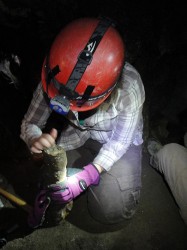Cave study designed to solve puzzle of prehistoric megadroughts in the western U.S.
Jessica Oster, assistant professor of earth and environmental sciences at Vanderbilt University, is using cave deposits to reconstruct past climates. The paleoclimatologist is also setting up an educational program to involve undergraduate, graduate, and high school students in the analysis of samples, design of independent research projects, and managing and manipulating data sets.
Read the full Research News at Vanderbilt article here, or read an excerpt below.
As California copes with its fourth year of drought, it raises the question, “Is the Golden State entering a period when megadroughts become the new normal?”
“There is evidence of a period of megadroughts in the paleoclimatic record of the western U.S., but the atmospheric drivers that caused them are a puzzle,” said Jessica Oster.

Oster is a member of a small community of earth scientists pioneering the use of the mineral deposits in caves as proxies for the prehistoric climate. She has received a five-year, $545,000 grant from the National Science Foundation to study the stalagmites in two California caves in order to shed new light on this puzzle: identifying the interplay of forces that produced extended drought in the region during the late Pleistocene and early Holocene.
This information should help climatologists determine whether the changing atmospheric conditions in the region caused by global warming are likely to increase the severity and duration of droughts.
The NSF Faculty Early Career Development award, which Oster received, is considered the National Science Foundation’s most prestigious honor for junior faculty members. They are given to exceptionally promising college and university junior faculty who are committed to the integration of research and education and who are most likely to become academic leaders.
Oster will also set up an ambitious educational program as part of the grant working with the Vanderbilt Center for Science Outreach, Metropolitan Nashville Public Schools and the School for Science and Math at Vanderbilt (SSMV), which is a joint venture between them.
The program will involve high school students and Vanderbilt undergraduate and graduate students. The Vanderbilt students will develop paleoclimatology lessons for a semester research project for a group of SSMV high school sophomores. The following year two of these students will become interns in Oster’s lab, where they will learn how to prepare and analyze samples during the year and participate in fieldwork the following summer.
As part of Vanderbilt’s “immersion initiative,” which encourages students to engage in creative research projects, two to three undergraduates will design and conduct independent research projects involving drought, caves and climate change. They will also act as mentors for the SSMV students.
After they become familiar with the subject, the SSMV students will work with Oster’s graduate students and experts at Vanderbilt’s Institute for Software Integrated Systems to develop an online “portal” that will make climate and paleoclimate databases accessible for high school science teachers.
“There are large climate and paleoclimate databases available online but they are designed for experts, not for laymen or students,” Oster explained. “Our students will spearhead a design effort to create web tools that they would want to use in the classroom.
“We hope this portal will make this information available to high school classrooms so the students can learn how to manipulate and analyze ‘big data,’ a skill that is becoming increasingly important in many professions.”

Leave a Response